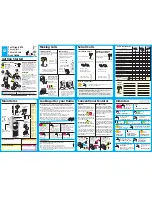
129
8
89
63
17
•
8
89
631
8
•
8
89
63
19
EN
REMOVAL / INSPECTION
/ MAINTENANCE / REPLACEMENT
OF THE SPARK PLUG
y
For the problem-free starting and operation of the engi-
ne, the electrodes of the spark plug must not be clo-
gged, the spark plug must be correctly set and installed.
•
ATTENTION
y
When gas is used frequently for powering the
generator, standard ignition spark plugs inten-
ded for petrol may have a shorter lifespan due
to the higher combustion temperatures of gas
compared to petrol. There are NGK ignition
spark plugs available on the market with a sur-
face layer containing iridium and/or platinum,
which is intended for higher temperatures.
These spark plugs are, however, more expensi-
ve than standard spark plugs. It is thus neces-
sary to weigh up more frequent replacement of
standard spark plugs against more durable and
longer-lasting spark plugs containing iridium
and/or platinum.
•
WARNING
y
The engine and the exhaust pipe are very hot while
the generator is running and for a long time after it has
been turned off. Therefore, be very careful to avoid bur-
ning yourself.
1. Take off the spark plug connector (fig. 12) and
remove the spark plug using the correct spark plug
wrench key.
2. Visually inspect the exterior appearance of the
spark plug.
y
In the event that the spark plug has clogged electro-
des, file them using sandpaper or steel brush if
necessary (fig. 13).
y
If the spark plug is visibly significantly clogged or if
the insulator is cracked or it is peeling, replace the
spark plug with a new one.
y
Using a gauge, check that the distance between the
electrodes is 0.6-0.8 mm and that the gasket ring is
in order (fig. 14).
3. Then screw the spark plug back in by hand.
4. Once the spark plug is screwed in, tighten it using
a spark plug wrench to compress the gasket ring.
Note
y
After hand tightening the new spark plug, it is neces-
sary to turn it by approx. 1/2 a rotation to compress
the gasket ring. If this is a reused older spark plug, it is
only necessary to tighten it by 1/8 to 1/4 of a rotation.
A spark plug is a consumable good, and its wear
and tear is not covered by the warranty.
•
ATTENTION
y
Make sure that the spark plug is well tightened. An
incorrectly tightened spark plug clogs and heats up
significantly and could seriously damage to the engine.
5. Place the spark plug connector back on to the
spark plug so that it clicks in place.
•
ATTENTION
y
In the event that it is not possible to start up the gene-
rator even with a cleaned spark plug, replace the spark
plug with a new one.
MAINTENANCE OF THE PETROL
FILTRATION STRAINER IN THE
REFILL NECK OF THE FUEL TANK
1. Screw open the fuel cap and remove the strainer
inserted in the neck of the fuel tank (fig. 15). Rinse
the strainer in any non-flammable cleaning agent
(e.g. detergent solution), or it is also possible to
use a brush with plastic bristles and then rinse the
strainer under clean water and allow it to dry tho-
roughly so that water does not come into contact
with petrol. In the even that the strainer is excessi-
vely soiled, replace it with a new original one.
2. Return the cleaned strainer back into the neck of
the fuel tank.
3. Put the fuel tank cap back on and tighten it firmly.
PURGING THE CARBURETTOR
1. Shut off the petrol supply to the carburettor using
the fuel valve.
2. Place an appropriate container underneath the
drain bolt of the carburettor and then screw out
the drain bolt of the carburettor and drain the
dirty material into the prepared container (fig. 16).
•
ATTENTION
y
Petrol will start flowing out of the loosened screw.
Purge the carburettor ideally outdoors since petrol
fumes are damaging to health. Likewise, use appropri-
ate waterproof protective gloves to prevent the skin
from being sprayed with petrol. Petrol is absorbed
through the skin into the body! Purge the carburettor
away from any sources of flames and do not smoke.
3. To purge the carburettor, open the fuel supply
using the fuel valve for a while to allow any dirty
material to flow out into a container. Then close
the fuel valve again to shut off the fuel supply.
4. Then screw the carburettor drain screw with the
gasket washer back in and tighten firmly. After
opening the fuel valve, check that no fuel is lea-
king around the bolt.







































